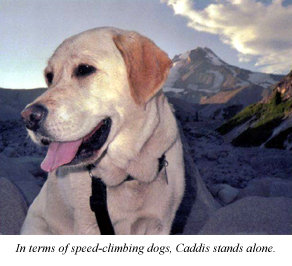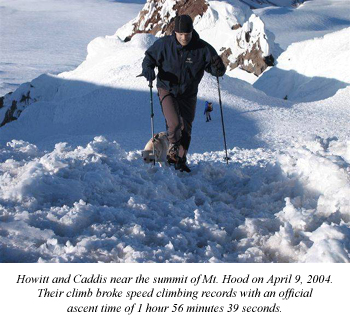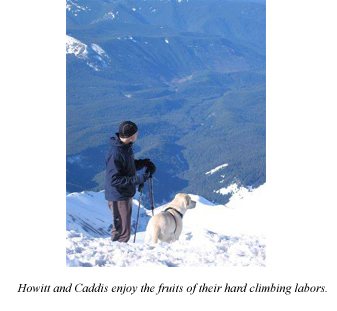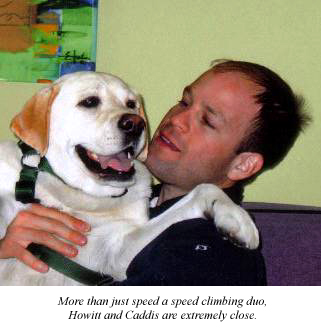


Christmas Store
The holidays are just around the corner so now is the time to fetch the finest gifts for the Labrador Lover on your Christmas list. We have over 100 gifts $50.00 and under. Visit our Christmas Store.
For the Lab
Bedding
Coats
Collars and Leads
Dog Bowls
Feeding Stations
Spa and Grooming
Toys and Treats
Travel and Accessories
For the Lab Lover
Apparel
Cards and Giftwrap
Fine Accessories
Gifts and All Occasions
Jewelry
Kids Only
For the Lab Home
Artwork
Books
Garden and Outdoor
Home Furnishings
Kitchen Accessories
Pillows, Throws, and Rugs
Gift ServicesGift Boxes
Gift Certificates
The Need for Speed
By Regan Michelle White
 Speed climber Dan Howitt, 36, and nine-year-old yellow Lab, Caddis, have a thing for speed. Residents of Portland, Oregon, the pair hold numerous speed climbing records on Mt. Hood and the Columbia River Gorge placed in 2004. Howitt himself is the first person to speed climb the peaks of Rainier, Shasta, Adams and Hood – let alone all in one summer (2003). And while the athletic feats are singularly newsworthy, there is something about this duo that makes each outing much more than a climb.
Speed climber Dan Howitt, 36, and nine-year-old yellow Lab, Caddis, have a thing for speed. Residents of Portland, Oregon, the pair hold numerous speed climbing records on Mt. Hood and the Columbia River Gorge placed in 2004. Howitt himself is the first person to speed climb the peaks of Rainier, Shasta, Adams and Hood – let alone all in one summer (2003). And while the athletic feats are singularly newsworthy, there is something about this duo that makes each outing much more than a climb.
Howitt shares Caddis with his older brother, David. David obtained Caddis at 6 weeks old from a Sauvie Island Lab breeder. When Caddis turned two, Howitt began sharing her with his brother when he moved to Portland. Intent on ensuring that she gets the exercise she needs each day, she is in Howitt’s charge during the daylight hours Monday through Friday. They typically train and exercise together from 1 to 5 or 6 p.m. David exercises Caddis Saturday through Sunday with light hikes one to two hours in length. Daily jaunts for Caddis and Howitt include parks in or on the edge of Portland that are known for their challenging terrain, hills and long trails – Forest Park, Mt. Tabor and Marquam Park. Together they tackle hill climbing and hiking with Howitt carrying water for both of them.
 Interestingly, it was these exercise outings that inspired Howitt to take their endeavors to the next level. “In early 2002 I finally got tired of our usual exercise outings,” Howitt said. “I wanted to try some mountain ranges, and we started in the Columbia River Gorge.” A mountain range rising sharply from the Columbia River, the Gorge’s most challenging route, Ruckle Ridge, is marked by an incline grade up to 40 percent in places and a very rough, narrow, unmaintained ridge-line trail which leaves little room for error. It was on this route that Howitt and Caddis began their speed climbing career. According to Howitt, it typically takes a well-conditioned climber more than four hours to reach the top and another three hours to descend. Howitt and Caddis climbed the route every week for more than three months, with Howitt clocking their progress. Their best ascent time was one hour, 22 minutes with a 47 minute descent. Howitt called a regional mountaineering group and was informed that their times, and the amount they were climbing Ruckle Ridge (most climbers attempt the route only once a year due to its rigor), placed them in the elite performance range, or top .5 percent of climbers.
Interestingly, it was these exercise outings that inspired Howitt to take their endeavors to the next level. “In early 2002 I finally got tired of our usual exercise outings,” Howitt said. “I wanted to try some mountain ranges, and we started in the Columbia River Gorge.” A mountain range rising sharply from the Columbia River, the Gorge’s most challenging route, Ruckle Ridge, is marked by an incline grade up to 40 percent in places and a very rough, narrow, unmaintained ridge-line trail which leaves little room for error. It was on this route that Howitt and Caddis began their speed climbing career. According to Howitt, it typically takes a well-conditioned climber more than four hours to reach the top and another three hours to descend. Howitt and Caddis climbed the route every week for more than three months, with Howitt clocking their progress. Their best ascent time was one hour, 22 minutes with a 47 minute descent. Howitt called a regional mountaineering group and was informed that their times, and the amount they were climbing Ruckle Ridge (most climbers attempt the route only once a year due to its rigor), placed them in the elite performance range, or top .5 percent of climbers.
The heat of summer eventually drove the duo further into the mountains and by mid-June Howitt decided to give Mt. Hood a shot. “It’s about one and a half hours from Portland and we went up there every week,” Howitt said. “We started slowly with how high we were going. It’s a dangerous peak with very unpredictable weather even in the summer with snow and glaciers all year, rock and ice fall in areas and a potentially deadly 60+ foot crevasse that lies at the bottom of a more than 40 degree slope you have to ascend. In a few weeks we were climbing to the summit.” Howitt marked their times and admitted they self-raced each climb they attempted. “We first were just over two hours to the summit from Timberline Lodge. Our best unofficial time was one hour and 55 minutes. I did it myself solo a few times and did a few ascents that averaged one hour and 40 minutes. This takes the typical climber six to 10 hours to do.”
Hiring third-party official timers from Climb Max Mountaineering, on April 9, 2004, Caddis and Howitt marked their first Mt. Hood speed climb, placing a 1:56:39sec ascent from the Timberline Lodge parking lot to the summit – a climb of more than 5,000 feet. They then returned to the Gorge in late summer and raced the top five routes of the mountain range, setting speed records on each of them, including breaking some past 1980s speed records placed by the lauded and controversial Steve Boyer.
If Howitt has learned anything it’s the importance of ensuring accuracy, accountability and certification through the expense of personally hiring professional third-party timers. Web sites across the Internet are rife with disputed speed climb claims – Howitt’s name among them. “In 2002 I did 5 speed climbs that were either self-timed or one’s where I used essentially random people on the mountain to help time me,” Howitt said. “I tried these means of time-verification first, but then realized a host of problems can occur with accuracy, so in 2003 I decided to spend thousands of dollars to hire people to time me … I’m one of the first people in U.S. history to have official speed records. … I only count my official times now.” In late 2003, Howitt started an organization called USA Mountain Speed Climbing, located at www.mountainspeedclimbing.org.
The Web site was recently acquired by an European group called Exposure and Howitt believes it will be the first truly objective group in the world to cover speed climbing across the world.
 Hazards of the climb, and laying claim to records aside, it hasn’t always been smooth sailing. “I had to learn most everything myself, and especially how to climb safely with a dog,” Howitt said. Howitt employs a substantial nylon harness for Caddis and attaches her to a rope-leash once they reach 10,000 feet. “Up the last half mile to the summit through the dangerous areas I have her go ahead of me so I can monitor how she is doing and so I have time to act if she slips,” he said. “I also have an ice axe in my other hand to aid in stopping both of us if either of us slips. The rope-leash is in my other hand.” Howitt added that he is a departure from most climbers who let their dogs fend for themselves and he knows that using the rope-leash with Caddis slows him down considerably by up to 15 minutes on Mt Hood for example due to monitoring her visually the entire time. The rope-leash climbing is slow because he waits for her to reach the end of the rope, then catches up, then waits again, etc. to insure that she is safe. But Howitt says “it is well worth it!”
Hazards of the climb, and laying claim to records aside, it hasn’t always been smooth sailing. “I had to learn most everything myself, and especially how to climb safely with a dog,” Howitt said. Howitt employs a substantial nylon harness for Caddis and attaches her to a rope-leash once they reach 10,000 feet. “Up the last half mile to the summit through the dangerous areas I have her go ahead of me so I can monitor how she is doing and so I have time to act if she slips,” he said. “I also have an ice axe in my other hand to aid in stopping both of us if either of us slips. The rope-leash is in my other hand.” Howitt added that he is a departure from most climbers who let their dogs fend for themselves and he knows that using the rope-leash with Caddis slows him down considerably by up to 15 minutes on Mt Hood for example due to monitoring her visually the entire time. The rope-leash climbing is slow because he waits for her to reach the end of the rope, then catches up, then waits again, etc. to insure that she is safe. But Howitt says “it is well worth it!”
On climbs Caddis is also equipped with Adidas glacier goggles to protect her eyes. “Caddis has never slipped or even wobbled,” Howitt said. “I on the other hand have bobbled here and there. She gets pretty low to the snow surface and moves seemingly effortlessly – the sign of a great athlete dog. With our daily outings her paw pads are already pretty tough the snow and ice have never made for problems. Other dogs that aren’t out as much would definitely need dog boots.”
In terms of speed-climbing dogs, Caddis stands alone. “Caddis is the first in history for Mt. Hood and any other glacier volcano mountain,” Howitt said. “I and other US speed-climbing specialists have never heard of another human-dog speed record on any mountain in the US or the world.” Despite her elite standing and clear athletic bent, Howitt believes her feats could be accomplished by other similarly trained dogs. “I think a lot of dogs could do it if they prepared like I prepare Caddis,” he said. “Two to four hours a day of training doing long, continuous hiking and hill climbing and never missing a day is good preparation.” Interestingly, the climbs are no picnic for Howitt. “For me, it’s actually extremely painful – mentally and physically. The training too is very tough all around – getting motivated to go out every day often in the torrential cold rain and mud of Oregon, the often cold and windy conditions on the mountains even in the middle of summer, hiring timers at great expense, planning a climb with the ever-changing weather and snow conditions and taking life-threatening risks.” He added that for Caddis it seems to be much more fun. “She seems to handle workouts really well and almost always has a big smile and bright look in her eyes,” he said. “On the few off-days per month when we do one to two hours of light walks and hikes, she actually seems to get very bored and has a sad, disinterested look. I think she thrives on the challenging activity. She is still very much this way at 9.5 years old and shows no signs of letting up. She is still much faster and stronger than me, by far.”
 Aside from being climbing partners who spend intense training hours together daily, Caddis and Howitt share a special bond. “I look out for her welfare and protect her and manager her medical care, and also play and talk to her quite a lot. She, like many dogs and especially Labradors, is very social and in touch with other humans. She is very responsive to tones of my voice and what is going on around her,” he said. Howitt loves how Labs in particular, “receive love so well and respond to it so well.” When not out tackling new climbs, Caddis loves to be with other people, particularly co-owner David. Caddis loves being taken to discover new places and likes to search through the house for her stuffed Elmo. Howitt believes it is of the utmost importance that owners take responsibility for the health and happiness of their dogs. “I really wish more people would have more involvement with their dogs, rather than, for example, leaving them home alone in a sensory deprived house or in a lonely yard all day when the owners are at work,” he said. “Dog day care for many hours during the day is, I’d argue, a minimal necessity. I feel most people who have dogs shouldn’t have them.”
Aside from being climbing partners who spend intense training hours together daily, Caddis and Howitt share a special bond. “I look out for her welfare and protect her and manager her medical care, and also play and talk to her quite a lot. She, like many dogs and especially Labradors, is very social and in touch with other humans. She is very responsive to tones of my voice and what is going on around her,” he said. Howitt loves how Labs in particular, “receive love so well and respond to it so well.” When not out tackling new climbs, Caddis loves to be with other people, particularly co-owner David. Caddis loves being taken to discover new places and likes to search through the house for her stuffed Elmo. Howitt believes it is of the utmost importance that owners take responsibility for the health and happiness of their dogs. “I really wish more people would have more involvement with their dogs, rather than, for example, leaving them home alone in a sensory deprived house or in a lonely yard all day when the owners are at work,” he said. “Dog day care for many hours during the day is, I’d argue, a minimal necessity. I feel most people who have dogs shouldn’t have them.”
While not out reaping new speed climbing records, Howitt does treatment and behavior research, writing and outreach in the medical field. He has been invited to do the Russian Mt. Elbus race and the Kilimanjaro race, but will not be attending. For now, he and Caddis will continue with their rigorous daily expedition workouts. “I put variety into every day, doing different trails, different kinds of workouts and going to different areas to train,” he said. “Caddis loves the variety I noticed that if we do an area too much that she gets kind of sick of it and is less eager to get out of the car and is less eager to start at the trailhead. But at a new place she’s really excited to get out of the car and tackle the trails and see what’s out there to look at.” And with the ground Caddis is covering, there certainly is a lot to see.
For those of you who would like more information on speed-climbing you can contact Dan directly at
danportlandor@yahoo.com
Click here to go back to Lab of the Month
By Regan Michelle White
 Speed climber Dan Howitt, 36, and nine-year-old yellow Lab, Caddis, have a thing for speed. Residents of Portland, Oregon, the pair hold numerous speed climbing records on Mt. Hood and the Columbia River Gorge placed in 2004. Howitt himself is the first person to speed climb the peaks of Rainier, Shasta, Adams and Hood – let alone all in one summer (2003). And while the athletic feats are singularly newsworthy, there is something about this duo that makes each outing much more than a climb.
Speed climber Dan Howitt, 36, and nine-year-old yellow Lab, Caddis, have a thing for speed. Residents of Portland, Oregon, the pair hold numerous speed climbing records on Mt. Hood and the Columbia River Gorge placed in 2004. Howitt himself is the first person to speed climb the peaks of Rainier, Shasta, Adams and Hood – let alone all in one summer (2003). And while the athletic feats are singularly newsworthy, there is something about this duo that makes each outing much more than a climb.Howitt shares Caddis with his older brother, David. David obtained Caddis at 6 weeks old from a Sauvie Island Lab breeder. When Caddis turned two, Howitt began sharing her with his brother when he moved to Portland. Intent on ensuring that she gets the exercise she needs each day, she is in Howitt’s charge during the daylight hours Monday through Friday. They typically train and exercise together from 1 to 5 or 6 p.m. David exercises Caddis Saturday through Sunday with light hikes one to two hours in length. Daily jaunts for Caddis and Howitt include parks in or on the edge of Portland that are known for their challenging terrain, hills and long trails – Forest Park, Mt. Tabor and Marquam Park. Together they tackle hill climbing and hiking with Howitt carrying water for both of them.
 Interestingly, it was these exercise outings that inspired Howitt to take their endeavors to the next level. “In early 2002 I finally got tired of our usual exercise outings,” Howitt said. “I wanted to try some mountain ranges, and we started in the Columbia River Gorge.” A mountain range rising sharply from the Columbia River, the Gorge’s most challenging route, Ruckle Ridge, is marked by an incline grade up to 40 percent in places and a very rough, narrow, unmaintained ridge-line trail which leaves little room for error. It was on this route that Howitt and Caddis began their speed climbing career. According to Howitt, it typically takes a well-conditioned climber more than four hours to reach the top and another three hours to descend. Howitt and Caddis climbed the route every week for more than three months, with Howitt clocking their progress. Their best ascent time was one hour, 22 minutes with a 47 minute descent. Howitt called a regional mountaineering group and was informed that their times, and the amount they were climbing Ruckle Ridge (most climbers attempt the route only once a year due to its rigor), placed them in the elite performance range, or top .5 percent of climbers.
Interestingly, it was these exercise outings that inspired Howitt to take their endeavors to the next level. “In early 2002 I finally got tired of our usual exercise outings,” Howitt said. “I wanted to try some mountain ranges, and we started in the Columbia River Gorge.” A mountain range rising sharply from the Columbia River, the Gorge’s most challenging route, Ruckle Ridge, is marked by an incline grade up to 40 percent in places and a very rough, narrow, unmaintained ridge-line trail which leaves little room for error. It was on this route that Howitt and Caddis began their speed climbing career. According to Howitt, it typically takes a well-conditioned climber more than four hours to reach the top and another three hours to descend. Howitt and Caddis climbed the route every week for more than three months, with Howitt clocking their progress. Their best ascent time was one hour, 22 minutes with a 47 minute descent. Howitt called a regional mountaineering group and was informed that their times, and the amount they were climbing Ruckle Ridge (most climbers attempt the route only once a year due to its rigor), placed them in the elite performance range, or top .5 percent of climbers.The heat of summer eventually drove the duo further into the mountains and by mid-June Howitt decided to give Mt. Hood a shot. “It’s about one and a half hours from Portland and we went up there every week,” Howitt said. “We started slowly with how high we were going. It’s a dangerous peak with very unpredictable weather even in the summer with snow and glaciers all year, rock and ice fall in areas and a potentially deadly 60+ foot crevasse that lies at the bottom of a more than 40 degree slope you have to ascend. In a few weeks we were climbing to the summit.” Howitt marked their times and admitted they self-raced each climb they attempted. “We first were just over two hours to the summit from Timberline Lodge. Our best unofficial time was one hour and 55 minutes. I did it myself solo a few times and did a few ascents that averaged one hour and 40 minutes. This takes the typical climber six to 10 hours to do.”
Hiring third-party official timers from Climb Max Mountaineering, on April 9, 2004, Caddis and Howitt marked their first Mt. Hood speed climb, placing a 1:56:39sec ascent from the Timberline Lodge parking lot to the summit – a climb of more than 5,000 feet. They then returned to the Gorge in late summer and raced the top five routes of the mountain range, setting speed records on each of them, including breaking some past 1980s speed records placed by the lauded and controversial Steve Boyer.
If Howitt has learned anything it’s the importance of ensuring accuracy, accountability and certification through the expense of personally hiring professional third-party timers. Web sites across the Internet are rife with disputed speed climb claims – Howitt’s name among them. “In 2002 I did 5 speed climbs that were either self-timed or one’s where I used essentially random people on the mountain to help time me,” Howitt said. “I tried these means of time-verification first, but then realized a host of problems can occur with accuracy, so in 2003 I decided to spend thousands of dollars to hire people to time me … I’m one of the first people in U.S. history to have official speed records. … I only count my official times now.” In late 2003, Howitt started an organization called USA Mountain Speed Climbing, located at www.mountainspeedclimbing.org.
The Web site was recently acquired by an European group called Exposure and Howitt believes it will be the first truly objective group in the world to cover speed climbing across the world.
 Hazards of the climb, and laying claim to records aside, it hasn’t always been smooth sailing. “I had to learn most everything myself, and especially how to climb safely with a dog,” Howitt said. Howitt employs a substantial nylon harness for Caddis and attaches her to a rope-leash once they reach 10,000 feet. “Up the last half mile to the summit through the dangerous areas I have her go ahead of me so I can monitor how she is doing and so I have time to act if she slips,” he said. “I also have an ice axe in my other hand to aid in stopping both of us if either of us slips. The rope-leash is in my other hand.” Howitt added that he is a departure from most climbers who let their dogs fend for themselves and he knows that using the rope-leash with Caddis slows him down considerably by up to 15 minutes on Mt Hood for example due to monitoring her visually the entire time. The rope-leash climbing is slow because he waits for her to reach the end of the rope, then catches up, then waits again, etc. to insure that she is safe. But Howitt says “it is well worth it!”
Hazards of the climb, and laying claim to records aside, it hasn’t always been smooth sailing. “I had to learn most everything myself, and especially how to climb safely with a dog,” Howitt said. Howitt employs a substantial nylon harness for Caddis and attaches her to a rope-leash once they reach 10,000 feet. “Up the last half mile to the summit through the dangerous areas I have her go ahead of me so I can monitor how she is doing and so I have time to act if she slips,” he said. “I also have an ice axe in my other hand to aid in stopping both of us if either of us slips. The rope-leash is in my other hand.” Howitt added that he is a departure from most climbers who let their dogs fend for themselves and he knows that using the rope-leash with Caddis slows him down considerably by up to 15 minutes on Mt Hood for example due to monitoring her visually the entire time. The rope-leash climbing is slow because he waits for her to reach the end of the rope, then catches up, then waits again, etc. to insure that she is safe. But Howitt says “it is well worth it!” On climbs Caddis is also equipped with Adidas glacier goggles to protect her eyes. “Caddis has never slipped or even wobbled,” Howitt said. “I on the other hand have bobbled here and there. She gets pretty low to the snow surface and moves seemingly effortlessly – the sign of a great athlete dog. With our daily outings her paw pads are already pretty tough the snow and ice have never made for problems. Other dogs that aren’t out as much would definitely need dog boots.”
In terms of speed-climbing dogs, Caddis stands alone. “Caddis is the first in history for Mt. Hood and any other glacier volcano mountain,” Howitt said. “I and other US speed-climbing specialists have never heard of another human-dog speed record on any mountain in the US or the world.” Despite her elite standing and clear athletic bent, Howitt believes her feats could be accomplished by other similarly trained dogs. “I think a lot of dogs could do it if they prepared like I prepare Caddis,” he said. “Two to four hours a day of training doing long, continuous hiking and hill climbing and never missing a day is good preparation.” Interestingly, the climbs are no picnic for Howitt. “For me, it’s actually extremely painful – mentally and physically. The training too is very tough all around – getting motivated to go out every day often in the torrential cold rain and mud of Oregon, the often cold and windy conditions on the mountains even in the middle of summer, hiring timers at great expense, planning a climb with the ever-changing weather and snow conditions and taking life-threatening risks.” He added that for Caddis it seems to be much more fun. “She seems to handle workouts really well and almost always has a big smile and bright look in her eyes,” he said. “On the few off-days per month when we do one to two hours of light walks and hikes, she actually seems to get very bored and has a sad, disinterested look. I think she thrives on the challenging activity. She is still very much this way at 9.5 years old and shows no signs of letting up. She is still much faster and stronger than me, by far.”
 Aside from being climbing partners who spend intense training hours together daily, Caddis and Howitt share a special bond. “I look out for her welfare and protect her and manager her medical care, and also play and talk to her quite a lot. She, like many dogs and especially Labradors, is very social and in touch with other humans. She is very responsive to tones of my voice and what is going on around her,” he said. Howitt loves how Labs in particular, “receive love so well and respond to it so well.” When not out tackling new climbs, Caddis loves to be with other people, particularly co-owner David. Caddis loves being taken to discover new places and likes to search through the house for her stuffed Elmo. Howitt believes it is of the utmost importance that owners take responsibility for the health and happiness of their dogs. “I really wish more people would have more involvement with their dogs, rather than, for example, leaving them home alone in a sensory deprived house or in a lonely yard all day when the owners are at work,” he said. “Dog day care for many hours during the day is, I’d argue, a minimal necessity. I feel most people who have dogs shouldn’t have them.”
Aside from being climbing partners who spend intense training hours together daily, Caddis and Howitt share a special bond. “I look out for her welfare and protect her and manager her medical care, and also play and talk to her quite a lot. She, like many dogs and especially Labradors, is very social and in touch with other humans. She is very responsive to tones of my voice and what is going on around her,” he said. Howitt loves how Labs in particular, “receive love so well and respond to it so well.” When not out tackling new climbs, Caddis loves to be with other people, particularly co-owner David. Caddis loves being taken to discover new places and likes to search through the house for her stuffed Elmo. Howitt believes it is of the utmost importance that owners take responsibility for the health and happiness of their dogs. “I really wish more people would have more involvement with their dogs, rather than, for example, leaving them home alone in a sensory deprived house or in a lonely yard all day when the owners are at work,” he said. “Dog day care for many hours during the day is, I’d argue, a minimal necessity. I feel most people who have dogs shouldn’t have them.”While not out reaping new speed climbing records, Howitt does treatment and behavior research, writing and outreach in the medical field. He has been invited to do the Russian Mt. Elbus race and the Kilimanjaro race, but will not be attending. For now, he and Caddis will continue with their rigorous daily expedition workouts. “I put variety into every day, doing different trails, different kinds of workouts and going to different areas to train,” he said. “Caddis loves the variety I noticed that if we do an area too much that she gets kind of sick of it and is less eager to get out of the car and is less eager to start at the trailhead. But at a new place she’s really excited to get out of the car and tackle the trails and see what’s out there to look at.” And with the ground Caddis is covering, there certainly is a lot to see.
For those of you who would like more information on speed-climbing you can contact Dan directly at
danportlandor@yahoo.com
Click here to go back to Lab of the Month
Featured Article
 Can You Spot The Holiday Hazards?
Can You Spot The Holiday Hazards?
It’s easy for pets, especially Labradors, to get into trouble during the holidays. You may get so busy that you lose track of what is going on with your dog.
Click here to learn more about: "Can You Spot The Holiday Hazards?"
 Can You Spot The Holiday Hazards?
Can You Spot The Holiday Hazards?It’s easy for pets, especially Labradors, to get into trouble during the holidays. You may get so busy that you lose track of what is going on with your dog.
Click here to learn more about: "Can You Spot The Holiday Hazards?"
Wanted: Models

Would you like to see your Lab pictured here? Send us images of your Lab and we may include them on our Home Page!

Would you like to see your Lab pictured here? Send us images of your Lab and we may include them on our Home Page!
Labrador Library
Labrador Links
The Verstaile Lab
History of the Lab
Advice
Travel
Featured Labs
Featured Artists
Labrador Links
The Verstaile Lab
History of the Lab
Advice
Travel
Featured Labs
Featured Artists
.jpg)

